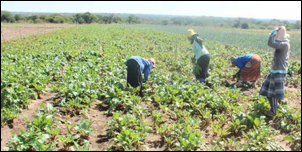SA’s land reform policies producing results
SA’s land reform policies producing results sadminSince 1994, government has transferred millions of hectares of land back to the black majority who were removed from their ancestral land over 100 years ago.
 According to the Twenty Year Review, in 1994 most agricultural land (83 per cent) was owned by whites and only 17 per cent of the land was available for black people in the former homelands.
According to the Twenty Year Review, in 1994 most agricultural land (83 per cent) was owned by whites and only 17 per cent of the land was available for black people in the former homelands.
As the country celebrates 20 Years of Freedom, efforts to undo this historical injustice are starting to bear fruit, even if it is at a slower pace than anticipated.
Following the democratic elections of 1994, government undertook to transfer 30 per cent of agricultural land (24.5 million hectares) to black people by 2014.
In his State of the Nation Address (SONA), President Jacob Zuma said so far 5 000 farms amounting to 4.2 million hectares have been transferred to black people benefiting over 200 000 families countrywide.
In 2009, government established a department that was given the responsibility of dealing with the land issue, specifically the social and economic development of rural areas in country.
The Ministry of Rural Development and Land Reform (DRDLR) was set up and government prioritised rural development and the needs of people living in rural areas.
Over the years government has introduced various initiatives and programmes aimed at accelerating the land transfer process. Among these initiatives is the approval of the Restitution of Land Rights Act in 1994.
The Act helped government in its effort to transfer land back to its rightful owners. Within a period of four years, the Act resulted in 80 000 claims lodged for restitution by 31 December 1998.
Programmes such as Comprehensive Rural Development Programme (CRDP), Recapitalisation and Development Programme (RADP), Agrarian Transformation, Land Reform and the National Rural Youth Service Corps (Narysec) were introduced with the aim to fast track the land reform and rural development process.
Comprehensive Rural Development Programme
Under the CRDP, 2 447 household food gardens have been established at various sites. By January 2013, over 2 600 beneficiaries were skilled in technical enterprise development trade.
Fifty-two councils of stakeholders, which are made up of government, labour, community development workers, civil society and business, have been established. These councils, with the help of government, plan, implement and oversee CRDP initiatives.
The CRDP has been rolled out to 157 rural wards, 143 698 poor households were profiled to assess their needs, 692km of fencing was erected in CRDP wards and 96km of roads were upgraded.
National Rural Youth Service Corps
Narysec is a youth skills, development and employment programme aimed at empowering rural youth from each of the 3 300 rural wards in the country.
The objective of Narysec is to recruit rural youth between the ages of 18 and 35 to provide services in their communities. Participants are contracted for 24 months following their recruitment.
Narysec was launched in 2011 as part of the National Youth Service with an initial 7 900 participants, of which about 4 500 have either received or are in the process of completing training in various skills.
Communal Property Associations
The Communal Property Associations (CPAs) Act allows communities to form associations called CPAs to acquire, hold and manage land on behalf of community members. Members of the CPA must live in the area where the land is situated. They ensure that the land is used and managed effectively for the benefit of the community.
Rural Cooperatives Finance Facility
Recently Rural Development and Land Reform Minister Gugile Nkwinti said government was planning to establish a facility to provide financial support to small-holder farmers.
“Going forward, the government will establish the Rural Cooperatives Finance Facility (Rucoff), to provide much needed financial and other technical support to a fledgling class of small-holder farmers and cooperatives in both commercial and communal land spaces.”
According to Minister Nkwinti, emerging small-holder farmers sought assistance from government.
“During interactions, emerging small-holder farmers and cooperatives have expressed a wish that the government procure from them so that they could grow and be sustainable.”
Transfer of land
While most of the arable land is still in the hands of the white minority, nearly 5 000 farms have been transferred to black people. Nearly 80 000 land claims, totalling 3.4 million hectares, have been settled and 1.8 million people have benefited.
 Though government has made progress in transferring land back to black people, a lot still needs to be done. The total amount of farmland transferred by means of restitution and redistribution is about 8 per cent, well short of the original 30 per cent target.
Though government has made progress in transferring land back to black people, a lot still needs to be done. The total amount of farmland transferred by means of restitution and redistribution is about 8 per cent, well short of the original 30 per cent target.
Since the inception of the land restitution programme in 1995, 79 696 claims were lodged, 77 334 have been settled of which 59 758 were finalised. The pace of settling these claims has improved over time as the system matures.
To overcome challenges facing government in the transferring land, the review suggests improving coordination between the spheres of government and implementation of rural development initiatives.
Pro-active citizens, private sector participation and expanding successful service models for rural areas are some of the ways identified as critical to assisting government to transfer land back to rightful owners.
During the SONA, President Zuma also said government should shorten the time it takes to finalise a claim.
“In this regard, government will now pursue the ‘just and equitable’ principle for compensation, as set out in the Constitution instead of the “willing buyer, willing seller” principle, which forces the state to pay more for land than the actual value,” he said.
President Zuma added that all was not lost for people who missed the deadline to lodge claims.
“…there are proposed amendments to the Restitution of Land Rights Act, 1994 in order to provide for the re-opening of the lodgement of restitution claims, by people who missed the deadline of 31 December 1998.”
He said another issue that would be “explored” was exceptions to the June 1913 cut-off date to accommodate claims by the descendants of the Khoi and San as well as heritage sites and historical landmarks.